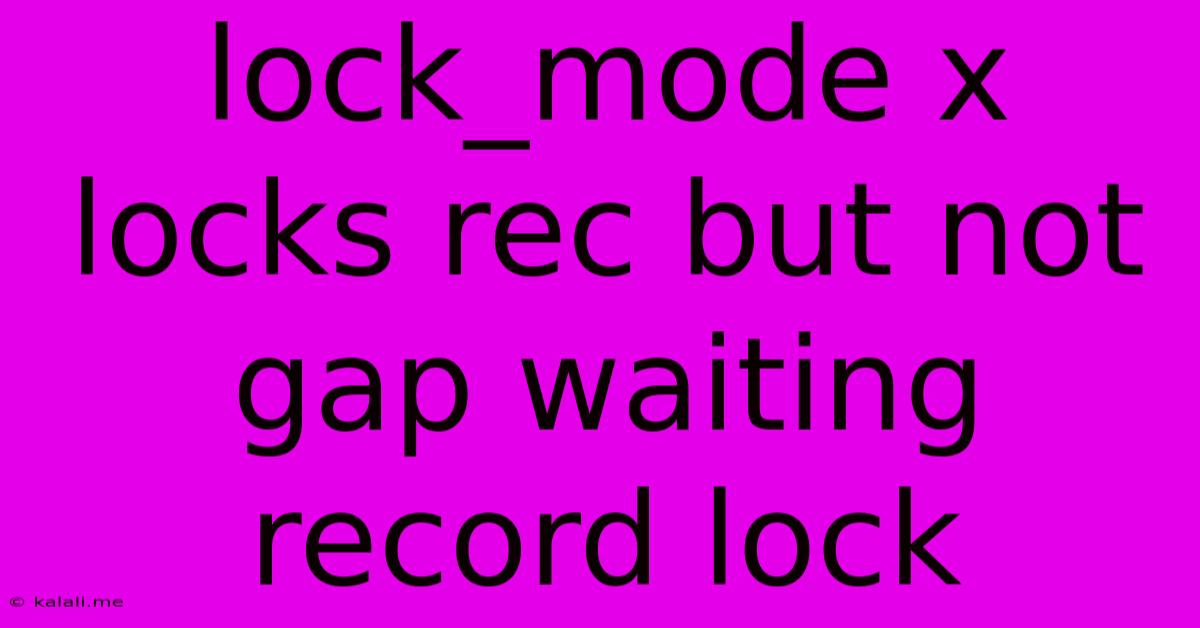Lock_mode X Locks Rec But Not Gap Waiting Record Lock
Kalali
May 23, 2025 · 3 min read

Table of Contents
Lock Mode X: Exclusive Locks, Record Locks, and the Absence of Gap Waiting
This article delves into the intricacies of lock mode X in database systems, specifically focusing on its behavior regarding record locks and the crucial absence of gap locking. Understanding these nuances is vital for developers working with concurrent transactions and ensuring data integrity. We'll explore what lock mode X entails, how it manages record locks, and why the lack of gap locking is a significant characteristic.
What is Lock Mode X?
Lock mode X, often referred to as an exclusive lock, is a type of database lock that grants a transaction exclusive access to a specific database record. This means that while a transaction holds an X lock on a record, no other transaction can read or write to that particular record. This is a critical mechanism for preventing data corruption and ensuring data consistency, especially in scenarios involving concurrent updates. Think of it as a "no entry" sign for other transactions trying to access the locked resource.
Record Locking with Lock Mode X:
When a transaction acquires a lock in mode X on a record, it establishes a record lock. This lock is solely on the specific record identified by the transaction. Only the transaction holding the X lock can modify or even read the data within that specific record. Other transactions attempting to access this locked record will be blocked until the lock is released. This blocking behavior is fundamental for preventing lost updates and dirty reads.
The Absence of Gap Locking:
Here's where a key distinction arises. Lock mode X, unlike other lock modes (such as shared locks or range locks), typically does not implement gap locking. Gap locking refers to the locking of gaps – the spaces between records – within a range of records. This means that if a transaction obtains an X lock on a specific record, other transactions can still access and modify records before or after the locked record, provided they do not attempt to modify the locked record itself.
Implications of No Gap Locking:
The absence of gap locking under lock mode X has important consequences:
-
Increased Concurrency: Transactions can proceed concurrently on records outside the scope of the locked record. This can lead to higher throughput and improved application performance, as transactions aren't needlessly blocked.
-
Phantom Reads: However, this increased concurrency comes with a potential drawback: phantom reads. A phantom read occurs when a transaction repeatedly reads a set of records and observes new records appearing within that set, even though the transaction hasn't explicitly modified anything. This can happen because another concurrent transaction inserted new records within the gap that wasn't locked.
-
Data Integrity Considerations: While phantom reads don't directly corrupt data, they can lead to inconsistent results and make it difficult to reason about data changes. Developers need to carefully consider the potential for phantom reads when designing applications that use lock mode X and to implement appropriate compensating measures.
Alternatives and Mitigation Strategies:
To address the potential issue of phantom reads when using lock mode X, developers can consider:
-
Range locks: Employing range locks, which lock a range of records instead of just individual records, can eliminate phantom reads. But this will, of course, decrease concurrency.
-
Serializable transactions: Using a serialization mechanism to ensure that transactions appear to execute one after another can eliminate concurrency issues like phantom reads.
-
Careful transaction design: Designing transactions carefully to minimize the likelihood of phantom reads occurring within the context of the application logic.
Conclusion:
Lock mode X, with its exclusive record locking and absence of gap locking, offers a balance between concurrency and data consistency. Understanding its characteristics – particularly the potential for phantom reads – is crucial for developing robust and reliable database applications. Choosing the appropriate locking strategy depends heavily on the specific needs and requirements of the application, weighing the potential benefits of increased concurrency against the risk of inconsistencies introduced by phantom reads. Careful consideration and appropriate mitigation strategies are key to leveraging the strengths of lock mode X while mitigating its potential drawbacks.
Latest Posts
Latest Posts
-
Number Of Possible Bridge Hands With At Least One Quad
May 23, 2025
-
Can You Plant Raspberries And Blackberries Together
May 23, 2025
-
What Can I Do With Someones Mac Addresss
May 23, 2025
-
Steam See Who Gifted Me Games
May 23, 2025
-
Fatal No Pg Hba Conf Entry For Host
May 23, 2025
Related Post
Thank you for visiting our website which covers about Lock_mode X Locks Rec But Not Gap Waiting Record Lock . We hope the information provided has been useful to you. Feel free to contact us if you have any questions or need further assistance. See you next time and don't miss to bookmark.